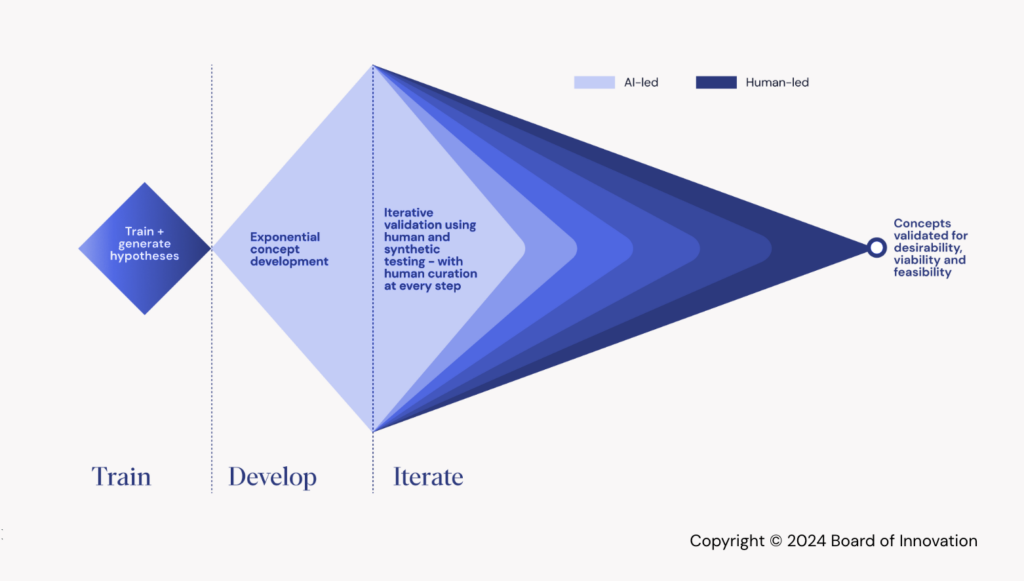The AI-powered ‘Stingray’ model for innovation

Managing Director Americas

Associate Business Director
Director APAC
For nearly two decades, the ‘Double Diamond’ model has dominated how people conceptualize, plan, and run design and innovation projects. Its strength has always been its ability to help teams identify ‘what problems to solve’ and ‘what solutions to build’ using a simple and structured approach of divergence and convergence.
Since 2005, thousands of individuals and teams across the globe have been trained in this model and undoubtedly many billions of dollars have been spent on projects driven by it. Its impact over the last two decades has been enormous, but in the present day environment of AI-powered innovation driven by results, at Board of Innovation we see that this model is increasingly heading towards obsolescence.

The Double Diamond: a model for yesterday’s innovation
The ‘Double Diamond’ approach originates from an era when innovation and design projects were constrained by the number of Post-It notes you could fit on a wall and the amount of data a human brain could consider and process. At this time, software for innovation teams meant PowerPoint, Excel and Photoshop – and ‘data science’ was a concept few had heard of. Needless to say we are not in that era anymore, and thanks to GenAI we are creating exponential innovative progress at an incredible pace.
In our work at Board of Innovation, we believe that the relevance of the Double Diamond model is slowly disintegrating. Koen Burghouts, Vice President of Innovation at PepsiCo, agrees, noting at our recent Autonomous Innovation Summit that;
In five years it might be that nobody is talking about the Double Diamond.
Three reasons why the Double Diamond model is losing relevance
1. Success in innovation is not about human thinking alone
Complex problem solving is no longer a matter of human thought alone. It’s about managing the complex interplay of human thought and artificial intelligence. Instead of spending weeks weighing a handful of problems or solutions at a surface level that we as humans find it hard to choose between, we can now immediately consider dozens at once, rapidly prioritize them and focus our time on learning more deeply about solutions that are more valuable.
2. It focuses resources on desirability - not feasibility and viability
When employing The Double Diamond, teams can spend weeks or even months interviewing customers and doing empathy research. While this work may lead to solutions that meet the needs of customers, oftentimes those solutions lack financial viability or technological feasibility.
We don’t need to follow this time consuming, impractical model anymore. From running innovation and business design projects with global clients, we’ve found that GenAI is incredibly effective at synthesizing consumer needs, discovered by humans, and picking out the concepts that are desirable. Teams can now cut to the chase, skip unnecessary steps, and focus their resources on developing concepts that are both desirable, feasible and viable.
3. It reinforces human biases and shortcomings
Teams usually have to wade through so much information that they will cut corners and fall prey to their own biases and shortcomings. They fall in love with solutions. They focus only on mainstream users rather than under-represented users, because it’s too complex to consider the needs of all. They are anchored to their own personal experiences and get stuck in established thinking patterns.
While early LLMs such as ChatGPT and Midjourney have their own biases, we have to understand that they are far easier to ‘re-train’ than humans – offering us the ability to overcome human biases and deliver truly inclusive solutions that meet the needs of a broader expanse of society – not just the limited number of people you managed to do empathy interviews with.
It’s time for a new model - the Stingray model

In recent years, there has been a general sense of failure among corporate innovation teams to deliver consistent results. Many companies have closed innovation labs or downsized teams to reduce costs or focus growth efforts on marketing and pricing initiatives around existing products and services. This has created added pressure for innovation teams to be more efficient and improve their success rate in the market.
The explosive emergence of Generative AI has led to the creation of a new model at Board of Innovation. One that utilizes the power of AI; the Stingray model. We have found that it increases investment confidence by delivering practical, validated solutions earlier in the process than was typically possible.
Say goodbye to spending three months identifying product ideas that can’t be made in your factory. Say goodbye to two-day Design Thinking workshops that leave people feeling that there are stones unturned. Say goodbye to having to make investment decisions based on the results of a small collection of interviews with mainstream audiences.
The Stingray model offers a new path for innovation teams by helping them to:
- Set more deliberate goals
- Work on tougher challenges
- Get to problems and solutions faster
- Eliminate unnecessary steps to allocate resources more effectively
- Focus on experimentation over empathy
- Overcome human bias
The three stages of the Stingray model
The “Train” stage
Setting goals and gathering intelligence
In this initial stage, teams work to set goals for a project. These teams establish the types of solutions they hope to find and define the metrics that will determine whether their goals can be achieved.
They then gather the relevant information necessary to find solutions to their problems. This information could take the form of proprietary information about the company’s customers or capabilities (e.g. its factory capabilities), or public information about competitor data, its supply chain costs (e.g. food crop prices), or consumer trends (e.g. what customers are saying on TikTok videos).
Once the information is assembled and the model trained, teams use it to generate a set of prioritized problem spaces and types of solutions that meet the goals for the project. For example, a team can determine the prioritized customer needs and example features for a digital service offering, which act as the main input to the next stage. The goal of these initial outputs is to act as a guidance mechanism for teams – helping them to see if they are on the right track or if they need to reset their goals before proceeding.
Key points of the “Train” stage:
- This stage delivers solid, prioritized hypotheses on problems and solutions, delivering a model that is tuned to act as a starting point for the rest of the project based on the set goals
- This stage doesn’t take weeks or months – it can take hours or days, depending on the level of human involvement and iteration wanted
- Once the model has been set up with relevant company-specific information, teams can run this stage iteratively by setting and resetting project goals – allowing you to effectively start and restart a project multiple times over
- We have begun developing custom software tools that build from methods we have developed for this stage. These tools help companies better run this project stage based on their proprietary data, priorities and strategy.
The “Develop” stage
Exponential exploration of problems and solutions at the same time
With the model set up to deliver the right type of outputs, the “Develop” stage allows teams to simultaneously generate both a very broad range of hypotheses as well as a variety of targeted solutions. They aren’t constrained by the need to think about problems first, and only then think about finding solutions. They aren’t limited by the need to consider only a few dozen ideas. They can be exponential and exhaustive in their analysis of the problem spaces under consideration.
The ‘Develop’ stage can run purely using AI as a co-pilot, or can be interwoven with human-run workshops that provide input from relevant experts. The output of this stage is a broad, categorized set of solutions that the team can feel confident about beginning to prioritize down from. It can create initial product or service descriptions, with visuals or prototypes, and initial hypotheses on features, feasibility and the ability of those solutions to deliver against the success metrics defined for the project.
Key points of the “Develop” stage:
- Teams can use a combination of human ideation, AI-led ideation, and AI-assisted ideation, but the latest research shows that AI-led ideation is a necessity. Nearly across the board it outperforms other methods in the quality and creativity of ideas it produces.
- Teams can begin to understand this exponential set of potential solutions by using AI to identify a clear and manageable set of ‘clusters’ of promising solutions that are ‘MECE’ (mutually exclusive and collectively exhaustive) – not just a mish-mash of thoughts
The “Iterate” stage
Iteratively validating practical solutions
With a broad set of potential solutions, teams then begin an iterative process of experimenting to narrow down, de-risk, and hone in on a more focused set of solutions. These solutions will have been validated for desirability, feasibility, viability, all at once – as well as incorporating other factors important to the business, for example sustainability goals. The newfound productivity provided by AI allows teams to focus on the type of iteration they always wished they could explore, but have rarely had the funds or the time available when following a traditional approach.
Teams will deploy a range of traditional design thinking and innovation methods. This includes running experiments with prototypes, conducting interviews with extreme or under-represented users, or running surveys., But teams should also put into action new methods such as synthetic testing. Conducting synthetic testing will narrow down a set of solutions using predictions about consumer behavior. This can include identifying improvements to an existing service concept and running autonomous interviews with real people that are conducted and synthesized by AI-enabled chatbots (e.g. using the Outset platform).
Key points of the “Iterate” stage:
- Humans will play a role at several stages of this journey in curating solutions to move forward, conducting real-world experimentation with prototypes, and getting expert input from industry stakeholders
- The potential for AI to enhance the iteration process is theoretically limitless – dependent on the training of AI models that is done. Models can be used, for example, to assess concepts based on real-time information about factory capabilities, supply chain costs, market trends, and many other inputs
- We are now experimenting with multi-agent AI models that help to assess and optimize product and service ideas against a variety of factors at once. For example, we can help ensure that a new product meets sustainability criteria as well as meeting customer needs, while being economically viable at the same time.
Getting started
At Board of Innovation, we have already adopted the ‘Stingray’ model on several projects with our clients.
We are using it to speed up the path to better validated concepts – as well as develop custom software platforms that help companies to run the ‘train’ stage in a confidential environment – by using their own brand, research, and industry data. We are also helping companies improve the quality of the “Iterate” stage by developing custom AI approaches based on their capabilities, technologies and the economics of their industry.
If you’re interested in learning more about the Stingray model and helping your leadership team understand it in a workshop, get in touch!
We partner with companies to develop real-world functional engines that – starting with simple prototypes that act as co-pilots for human users and building towards autonomous systems that transform product innovation, manufacturing, and go-to-market.


